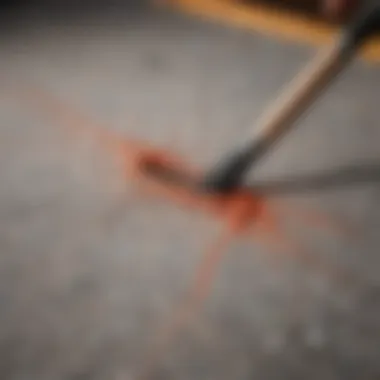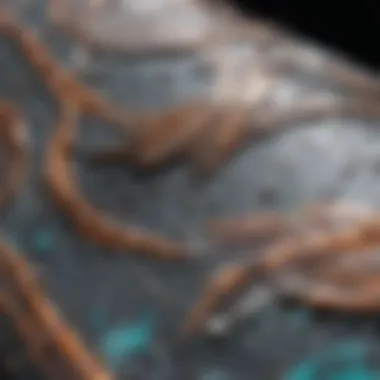Mastering the Art of Removing Paint Stains from a Shirt


This article immaculately dissects the intricate process vital for effectively eliminating paint stains from a shirt. It meticulously outlines the critical steps, from identifying the type of paint adorning the fabric to implementing precise stain removal techniques, essential for restoring the garment to its former pristine condition. Whether grappling with stubborn acrylic, oil-based, or watercolor paint stains, this guide offers comprehensive solutions tailored for a seamless restoration process.
Identifying the Paint Type
Before embarking on the removal journey, the initial crucial step involves identifying the type of paint that has besmirched your shirt. Whether dealing with the rich textures of acrylic, the vibrant hues of watercolor, or the resilient oil-based paints, distinguishing the specific paint type is fundamental to determining the most effective stain removal approach. A keen eye and perhaps a magnifying glass can aid in this detective work.
Choosing the Right Stain Removal Techniques
Once the type of paint is ascertained, the subsequent phase delves into selecting the optimal stain removal techniques. Different paints necessitate specific treatments; for example, watercolor paints may respond well to gentle soaking, while oil-based paints might demand the use of solvents. Delving into the realm of paint stain removal products can be overwhelming, with a myriad of options available, spanning from organic remedies to commercial stain removers designed for precision.
The Acrylic Paint Conundrum
Acrylic paint stains present a unique challenge due to their quick drying nature. Upon discovering an acrylic stain adorning your shirt, immediate action is imperative. Thoroughly blotting excess paint and avoiding the temptation to rub the stain are crucial. Employing cold water and mild detergent can aid in loosening the paint particles before proceeding with a meticulous stain removal strategy tailored for acrylic paints.
Tackling Oil-Based Paint Stains
Oil-based paint stains pose a formidable obstacle, requiring a strategic approach for successful removal. Due to the viscous nature of oil-based paints, swift intervention is key. Utilizing a combination of solvent-based stain removers, gentle scrubbing, and patience is vital in gradually lifting the stubborn oil-based paint from the fabric fibers. Taking a systematic and persistent stance is essential throughout this meticulous process.
Dealing with Watercolor Paint Mishaps
Watercolor paint stains may appear less daunting initially, but their subtle, translucent nature necessitates precise handling to prevent further spreading and absorption into the fabric. Blotting excess moisture and employing strategic techniques such as the use of white vinegar or baking soda can aid in gently dislodging the watercolor paint from the shirt's fibers. Patience and a gentle touch are paramount in salvaging the garment from this delicate predicament.
Synthesizing the Crucial Strategies
Introduction
When it comes to the meticulous task of eliminating pesky paint stains from a beloved shirt, every step counts in restoring the garment to its former pristine state. This guide will delve into the intricacies of effectively removing different types of paint stains, from water-based to oil-based and everything in between. By understanding the specific techniques and tools needed, you can tackle these stubborn stains with precision and care.
Understanding the Challenge
Different Types of Paint Stains
In the realm of paint stains, there exist various types that can pose a challenge to even the most adept stain removers. From watercolor to acrylic and oil-based paints, each type demands a specific approach for successful removal. Watercolor stains, known for their vibrant pigment but also their ability to permeate fabric quickly, require prompt attention to prevent setting. On the other hand, oil-based paints, with their rich texture and lasting effect, can be particularly stubborn to eradicate. Understanding the unique characteristics of each type enables tailored removal techniques for efficient results.
Impact of Drying Time on Stain Removal
One crucial factor to consider in the realm of paint stain removal is the drying time of the stain. The longer a paint stain is left to dry on fabric, the more challenging it becomes to eliminate. Prompt action is essential, especially for watercolor stains that tend to set rapidly. Quick intervention not only prevents deeper penetration of the paint into the fabric but also facilitates easier removal. By emphasizing the significance of timing in stain removal, this guide equips you with the knowledge needed to address paint stains effectively.


Materials Needed
Stain Remover
A reliable stain remover is a fundamental component in the arsenal against paint stains. Opt for a stain remover specifically formulated to combat paint stains, ensuring it is suitable for the fabric of your shirt. Look for products with powerful stain-lifting properties without causing damage to the garment. The right stain remover can make a significant difference in the success of the stain removal process.
Clean Cloth
A clean cloth plays a pivotal role in the stain removal process, allowing you to dab and blot the affected area without spreading the stain further. Choose a soft, lint-free cloth to prevent additional damage to the fabric. The clean cloth serves as your tool for gently lifting and absorbing the paint residue, aiding in the restoration of your shirt.
Water and Detergent
Water and detergent form the basic yet essential components for treating paint stains. Cold water works effectively in diluting watercolor paint stains, while liquid detergent aids in breaking down oil-based paint residues. Together, water and detergent create a basic yet potent solution for pre-treating and laundering paint-stained garments, preparing them for further stain removal techniques.
Preparation Steps
Assessing the Stain
Before embarking on the removal process, it is crucial to assess the severity of the paint stain. Determine the type of paint involved, the extent of the stain, and the fabric of the shirt to tailor your approach accordingly. Differentiate between watercolor, acrylic, or oil-based stains to select the most appropriate removal method. Assessing the stain sets the stage for a targeted and effective stain removal strategy.
Checking Fabric Care Labels
Consulting the fabric care labels of your shirt is vital in preventing damage during the stain removal process. These labels provide essential information on recommended cleaning methods, water temperature limits, and any specific precautions to take. By following the guidelines on the fabric care labels, you ensure that your shirt receives the appropriate care without risking potential fabric damage. Checking these labels is a proactive step towards successful stain removal.
Techniques for Water-Based Paint
When it comes to the intricate process of removing paint stains from a shirt, understanding the nuances of water-based paint is crucial. Water-based paints, although easier to clean than oil-based alternatives, still present a challenge when they find their way onto fabric. The key to successfully tackling water-based paint stains lies in the meticulous application of specific techniques tailored to this type of paint.
Blotting the Stain
In the world of stain removal, the technique of blotting the stain with precision is a fundamental step in the right direction. This method involves delicately dabbing at the stain using strategic motions to prevent it from spreading further across the fabric. Within this process, the significance of employing cold water and liquid detergent cannot be overlooked.
Using Cold Water
A critical element in the realm of stain removal, using cold water offers a myriad of benefits when combatting water-based paint stains. The low temperature of cold water helps prevent the paint from setting further into the fabric, thereby facilitating easier removal. The unique feature of cold water lies in its ability to preserve the integrity of the fabric while effectively loosening the paint particles for a more seamless cleaning process.
Applying Liquid Detergent
Liquid detergent plays a vital role in the battle against water-based paint stains due to its exceptional properties. Liquid detergents are formulated to target oil and water-based stains, making them a popular choice for stain removal. The key characteristic of applying liquid detergent is its ability to break down the paint molecules, making them easier to lift off the fabric. However, it is essential to note that excessive use of liquid detergent may result in residue build-up, affecting the fabric's quality.


Soaking and Washing
Further enhancing the efficacy of removing water-based paint stains from a shirt involves the techniques of soaking in a vinegar solution and following machine wash instructions meticulously.
Soaking in Vinegar Solution
The process of soaking the affected area in a vinegar solution proves to be highly beneficial in loosening the grip of water-based paint stains. Vinegar's acidic nature aids in breaking down the paint particles, thereby easing their removal during subsequent cleaning. When executed correctly, soaking in a vinegar solution can significantly improve the overall success rate of eliminating water-based paint stains from fabric.
Machine Wash Instructions
Adhering to appropriate machine wash instructions after applying stain removal techniques is paramount in ensuring the optimal outcome. Following the manufacturer's guidelines on water temperature, cycle selection, and detergent usage is crucial to prevent any potential damage to the fabric while effectively eliminating the remnants of the water-based paint. By meticulously following machine wash instructions, you can bid farewell to stubborn water-based paint stains, restoring your shirt to its pristine state.
Strategies for Oil-Based Paint
Oil-based paint stains can be particularly stubborn to remove from clothing, requiring specific strategies for effective stain removal. This section delves into the importance of addressing oil-based paint stains in the context of this comprehensive guide. Understanding the unique characteristics and challenges posed by oil-based paints is crucial for successfully restoring your garment. By emphasizing gentle yet effective approaches, this article equips readers with the knowledge needed to tackle even the most resilient oil-based paint stains.
Gentle Scrubbing Techniques
When it comes to dealing with oil-based paint stains, gentle scrubbing techniques play a vital role in the stain removal process. Two key methods employed in this article are using a toothbrush and employing rubbing alcohol.
Using a Toothbrush
The utilization of a toothbrush offers a targeted and precise approach to tackling oil-based paint stains. The bristles of a toothbrush enable individuals to scrub the affected area gently, ensuring thorough removal without damaging the fabric. This technique's effectiveness lies in its ability to reach small crevices and textures in the fabric, enhancing the overall stain removal process. Although manual, this method proves to be popular among individuals seeking a hands-on stain removal solution due to its meticulous nature.
Employing Rubbing Alcohol
Employing rubbing alcohol is a strategic choice for combating oil-based paint stains due to its solvent properties. Rubbing alcohol works effectively to break down the paint's compounds, facilitating easier removal from the fabric. Its quick evaporation rate minimizes the risk of saturating the fabric excessively, making it a preferred option for treating oil-based paint stains. However, caution must be exercised to prevent excessive use, as it can potentially damage certain fabric types when applied in large quantities.
Removing Stubborn Stains
Some oil-based paint stains may require additional interventions to ensure complete removal. This section explores two advanced techniques, namely applying ammonia solution and professional dry cleaning, to address stubborn stains effectively.
Applying Ammonia Solution
Integrating an ammonia solution into your stain removal regimen can be pivotal in combating persistent oil-based paint stains. Ammonia's chemical composition aids in dissolving tough paint residues, loosening their bond with the fabric for easier removal. The unique feature of ammonia lies in its ability to penetrate deep into the fabric layers, targeting embedded paint particles that may resist traditional cleaning methods. While effective, cautious application is advised, as excessive use of ammonia can potentially cause discoloration or damage to certain fabric blends.
Professional Dry Cleaning


For oil-based paint stains that prove to be extremely resistant or delicate to treat at home, seek the assistance of professional dry cleaning services. Professional dry cleaners possess the expertise and specialized equipment required to address tough oil-based paint stains effectively. By entrusting your garment to professionals, you can ensure thorough and safe removal of the stain without risking damage to the fabric. This premium service is ideal for valuable clothing items or complex stains that necessitate professional care.
Dealing with Acrylic Paint Residue
When it comes to the meticulous process of removing paint stains, understanding how to deal specifically with acrylic paint residue is crucial. Acrylic paint, known for its quick-drying nature and resistant properties, can be a challenge to remove once it settles onto fabric. The importance of this topic lies in the need to provide tailored solutions to effectively combat acrylic paint stains, ensuring the restoration of garments without causing damage. By focusing on specific elements such as the composition of acrylic paint and its adherence to fabric fibers, this section delves into comprehensive techniques to address this unique stain type.
Freezing and Scrape Technique
As part of the arsenal of solutions for acrylic paint residue, the freezing and scrape technique stands out for its innovative approach to stain removal. One of the notable aspects within this technique involves the utilization of ice cubes. Ice cubes play a pivotal role in the process by effectively freezing the paint residue, causing it to harden and lose its grip on the fabric fibers. This method is particularly beneficial for delicate fabrics, as it minimizes the risk of damage during the stain removal process. The unique feature of using ice cubes lies in its non-invasive nature, offering a gentle yet effective solution to tackle acrylic paint stains with precision.
Scraping with a Blunt Tool
In conjunction with the freezing process, scraping with a blunt tool proves to be an essential step in eliminating acrylic paint residue from fabric. The key characteristic of this technique lies in its ability to delicately dislodge hardened paint particles without causing harm to the fabric fibers. By employing a blunt tool such as a plastic spatula or a spoon, individuals can carefully scrape off the frozen paint, ensuring thorough removal while safeguarding the fabric's integrity. This method's advantage lies in its precision, allowing users to target specific areas of the stain without resorting to harsh measures that could potentially damage the garment. However, it is important to exercise caution to prevent accidental tearing or stretching of the fabric.
Washing and Rinsing
Following the freezing and scraping process, washing and rinsing the fabric becomes imperative to complete the stain removal procedure effectively. A key aspect of this stage involves a warm water rinse, which helps to further loosen any residual paint particles and detergent remnants from the fabric. The warm water rinse is a popular choice for this article due to its ability to enhance the cleansing process without causing damage to the garment. Its unique feature lies in its gentle approach, ensuring the removal of paint residue while maintaining the fabric's quality and color vibrancy.
Repeat Washing if Necessary
In instances where stubborn paint stains persist, the option to repeat washing becomes a viable solution to achieve thorough removal. Repeat washing if necessary allows individuals to target specific areas of the stain repeatedly, ensuring that any remnants of acrylic paint are effectively eradicated. The key characteristic of this technique is its persistence in stain removal, offering a comprehensive approach to tackling stubborn acrylic paint residue. One advantageous aspect of repeat washing is its customizable nature, allowing users to adjust the intensity and duration of washing cycles based on the severity of the stain. However, it is essential to exercise moderation to prevent excessive wear on the fabric.
Final Steps and Recommendations
When it comes to the final steps and recommendations in the process of removing paint stains from a shirt, attention to detail is paramount. These concluding actions play a crucial role in ensuring the successful restoration of your garment. Properly executing the final steps can mean the difference between a pristine shirt and one still marred by paint residue. Therefore, adhering to these recommendations is essential for achieving optimal outcomes.
Air Drying and Inspection
Avoiding Heat Drying
Avoiding heat drying is a fundamental aspect that cannot be emphasized enough. Opting to air dry the shirt instead of subjecting it to the heat of a dryer is highly beneficial. Heat can set paint stains further into the fabric, making them more challenging to remove in subsequent washes. By allowing the shirt to air dry naturally, you give the cleaning agents ample time to work on the stains effectively, leading to a higher likelihood of complete removal. Additionally, air drying is a more gentle approach, preserving the fabric's integrity and color vibrancy.
Examining for Residual Stains
Thoroughly examining the shirt for any residual stains after the cleaning process is a critical step. Even if the paint stain seems to have disappeared during the washing process, residues could still be lurking subtly. Careful scrutiny under good lighting is necessary to detect any leftover traces of paint. This meticulous inspection ensures that no remnants are overlooked, guaranteeing a truly clean and spotless shirt. Addressing any remaining stains promptly will prevent them from becoming more stubborn over time and reappearing after subsequent washes.
Professional Assistance
Consulting Dry Cleaners
Consulting dry cleaners can be a wise move for particularly stubborn or delicate paint stains. Professional dry cleaning services possess the expertise and specialized equipment needed to tackle tough stains effectively. By entrusting your stained shirt to experienced professionals, you increase the chances of complete stain removal without causing any damage to the fabric. Moreover, dry cleaners can provide personalized recommendations based on the specific type of paint stain and fabric of your shirt, ensuring a tailored approach to stain removal.
Seeking Tailored Advice
Seeking tailored advice from professionals in the field of garment care is another valuable option. These experts can provide insights and strategies tailored to your unique situation. By consulting individuals with a deep understanding of stains and fabric care, you gain access to innovative techniques and resources that may not be readily available to the general public. Seeking tailored advice is especially beneficial when dealing with rare or complex paint stains that require specialized treatment strategies for successful removal.







